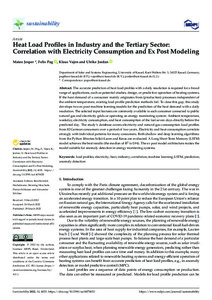| dc.date.accessioned | 2022-05-30T13:42:26Z | |
| dc.date.available | 2022-05-30T13:42:26Z | |
| dc.date.issued | 2022-03-29 | |
| dc.identifier | doi:10.17170/kobra-202205176194 | |
| dc.identifier.uri | http://hdl.handle.net/123456789/13876 | |
| dc.description.sponsorship | Gefördert durch den Publikationsfonds der Universität Kassel | ger |
| dc.language.iso | eng | eng |
| dc.rights | Namensnennung 4.0 International | * |
| dc.rights.uri | http://creativecommons.org/licenses/by/4.0/ | * |
| dc.subject | load profiles | eng |
| dc.subject | electricity | eng |
| dc.subject | heat | eng |
| dc.subject | industry | eng |
| dc.subject | correlation | eng |
| dc.subject | machine learning | eng |
| dc.subject | LSTM | eng |
| dc.subject | prediction | eng |
| dc.subject | anomaly detection | eng |
| dc.subject.ddc | 600 | |
| dc.title | Heat Load Profiles in Industry and the Tertiary Sector: Correlation with Electricity Consumption and Ex Post Modeling | eng |
| dc.type | Aufsatz | |
| dcterms.abstract | The accurate prediction of heat load profiles with a daily resolution is required for a broad range of applications, such as potential studies, design, or predictive operation of heating systems. If the heat demand of a consumer mainly originates from (production) processes independent of the ambient temperature, existing load profile prediction methods fail. To close this gap, this study develops two ex post machine learning models for the prediction of the heat demand with a daily resolution. The selected input features are commonly available to each consumer connected to public natural gas and electricity grids or operating an energy monitoring system: Ambient temperature, weekday, electricity consumption, and heat consumption of the last seven days directly before the predicted day. The study’s database covers electricity and natural gas consumption load profiles from 82 German consumers over a period of two years. Electricity and heat consumption correlate strongly with individual patterns for many consumers. Both shallow and deep learning algorithms from the Python libraries Scikit-Learn and Keras are evaluated. A Long Short-Term Memory (LSTM) model achieves the best results (the median of R2 is 0.94). The ex post model architecture makes the model suitable for anomaly detection in energy monitoring systems. | eng |
| dcterms.accessRights | open access | |
| dcterms.creator | Jesper, Mateo | |
| dcterms.creator | Pag, Felix | |
| dcterms.creator | Vajen, Klaus | |
| dcterms.creator | Jordan, Ulrike | |
| dc.relation.doi | doi:10.3390/su14074033 | |
| dc.relation.issupplementedby | doi:10.48662/daks-9 | |
| dc.subject.swd | Lastprofil | ger |
| dc.subject.swd | Elektrizität | ger |
| dc.subject.swd | Hitze | ger |
| dc.subject.swd | Industrie | ger |
| dc.subject.swd | Maschinelles Lernen | ger |
| dc.subject.swd | Prognose | ger |
| dc.subject.swd | Anomalieerkennung | ger |
| dc.type.version | publishedVersion | |
| dcterms.source.identifier | eissn:2071-1050 | |
| dcterms.source.issue | Issue 7 | |
| dcterms.source.journal | Sustainability | eng |
| dcterms.source.volume | Volume 14 | |
| kup.iskup | false | |
| dcterms.source.articlenumber | 4033 | |


